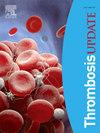Hospitalizations for bleeding associated with apixaban versus rivaroxaban according to dose in Medicare beneficiaries
Q4 Medicine
引用次数: 0
Abstract
Introduction
Apixaban and rivaroxaban are the most prescribed direct oral anticoagulants, and the safety of different doses in patients at high risk for bleeding is not fully defined. The objective of this study was to compare the rate of hospitalizations due to bleeding in patients prescribed apixaban versus rivaroxaban at specific doses.
Methods
We conducted a retrospective cohort study of more than 1.9 million Medicare beneficiaries who filled prescriptions for apixaban or rivaroxaban from 2014 to 2020 using the Medicare Parts A, B, C and D encounter and prescription claims database. The primary outcomes measured were hospitalizations due to bleeding categorized by location (intracranial, gastrointestinal [GI], and other) and all-cause mortality.
Results
Among the population studied, 1,022,170 (53 %) filled a prescription for apixaban 5 mg during the study period, followed by rivaroxaban 20 mg (27 %) and rivaroxaban 10 mg (11 %). Compared to the reference group of apixaban 5 mg, combination prescriptions for rivaroxaban 15–20 mg were associated with more than twice the risk of hospitalization due to GI bleeding (hazard ratio [HR] = 2.41, 95 % confidence interval [CI]: 2.15–2.70) and other bleeding (HR = 2.42, 95 % CI: 1.92–3.05) and were associated with a 51 % higher risk of hospitalization due to intracranial bleeding (HR = 1.51, 95 % CI: 1.15–1.98). There were 88,740 (4.6 %) deaths during the study period, with a 27 % increased risk of death associated with prescriptions for apixaban 2.5 mg (HR = 1.27, 95 % CI: 1.24–1.30) and a 19 % decreased risk of death associated with prescriptions for rivaroxaban 10 mg (HR = 0.81, 95 % CI: 0.78–0.85).
Conclusion
Rivaroxaban doses of 15 mg and greater were associated with higher bleeding risk. This data may aid clinicians in making an informed decision when prescribing specific doses of apixaban and rivaroxaban, particularly for patients with a high risk of bleeding.
根据医疗保险受益人的剂量,阿哌沙班与利伐沙班相关的出血住院
阿哌沙班和利伐沙班是处方最多的直接口服抗凝剂,不同剂量对高危出血患者的安全性尚未完全确定。本研究的目的是比较特定剂量阿哌沙班和利伐沙班患者因出血而住院的比率。方法:我们对2014年至2020年期间处方阿哌沙班或利伐沙班的190多万医疗保险受益人进行了回顾性队列研究,使用医疗保险a、B、C和D部分的遭遇和处方索赔数据库。测量的主要结局是因出血(颅内、胃肠道[GI]和其他)和全因死亡率而住院的情况。结果在研究人群中,1,022170人(53%)在研究期间服用阿哌沙班5mg,其次是利伐沙班20mg(27%)和利伐沙班10mg(11%)。与阿哌沙班5 mg对照组相比,联合处方利伐沙班15-20 mg组因胃肠道出血(风险比[HR] = 2.41, 95%可信区间[CI]: 2.15-2.70)和其他出血(HR = 2.42, 95% CI: 1.92-3.05)住院的风险增加了一倍以上,因颅内出血住院的风险增加了51% (HR = 1.51, 95% CI: 1.15-1.98)。在研究期间有88,740例(4.6%)死亡,处方阿哌沙班2.5 mg的死亡风险增加27% (HR = 1.27, 95% CI: 1.24-1.30),处方利伐沙班10 mg的死亡风险降低19% (HR = 0.81, 95% CI: 0.78-0.85)。结论利伐沙班15mg及以上剂量患者出血风险较高。这些数据可以帮助临床医生在处方特定剂量的阿哌沙班和利伐沙班时做出明智的决定,特别是对于出血高风险的患者。
本文章由计算机程序翻译,如有差异,请以英文原文为准。
求助全文
约1分钟内获得全文
求助全文

 求助内容:
求助内容: 应助结果提醒方式:
应助结果提醒方式:


